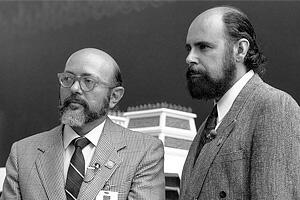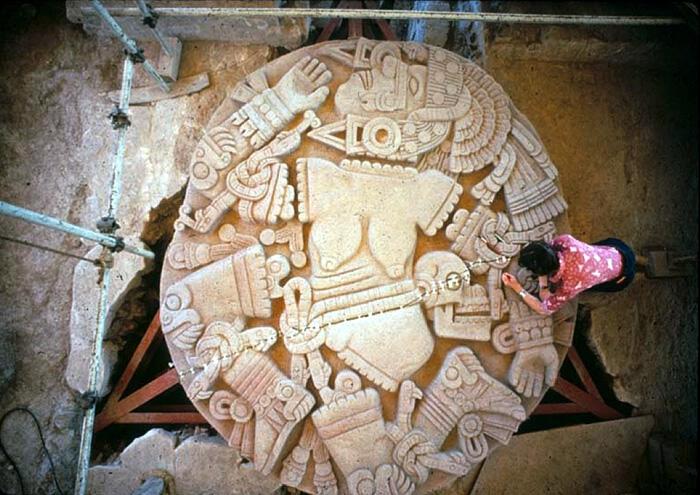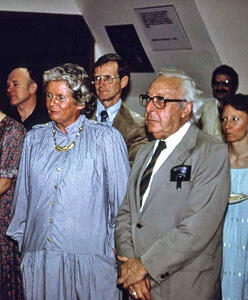 The Mesoamerican Archive and Research Project (MARP) was officially established in 1984 through the intellectual collaboration of historian of religions Davíd Carrasco, archaeologist Eduardo Matos Moctezuma, and archaeoastronomer Anthony Aveni. A letter of introduction from the highly-respected archaeologist Pedro Armillas had first brought Carrasco and Matos together in 1976, when Carrasco was conducting field research in Mexico while at the University of Chicago, and Matos was director of Pre-Hispanic Monuments. Carrasco recognized a certain symmetry in Matos’s first book, Muerte a filo de obsidiana (Death by Obsidian Blade, 1975), between archaeology and the discipline of the History of Religions in the ways that the author interpreted ritual practices of death and sacrifice among ancient Nahuas in the Basin of Mexico. This meeting initiated an ongoing collaboration between the Mexican American historian of religions and the Mexican archaeologist who came to change the way collaborative and scientific archaeology was carried out in the Americas.
The Mesoamerican Archive and Research Project (MARP) was officially established in 1984 through the intellectual collaboration of historian of religions Davíd Carrasco, archaeologist Eduardo Matos Moctezuma, and archaeoastronomer Anthony Aveni. A letter of introduction from the highly-respected archaeologist Pedro Armillas had first brought Carrasco and Matos together in 1976, when Carrasco was conducting field research in Mexico while at the University of Chicago, and Matos was director of Pre-Hispanic Monuments. Carrasco recognized a certain symmetry in Matos’s first book, Muerte a filo de obsidiana (Death by Obsidian Blade, 1975), between archaeology and the discipline of the History of Religions in the ways that the author interpreted ritual practices of death and sacrifice among ancient Nahuas in the Basin of Mexico. This meeting initiated an ongoing collaboration between the Mexican American historian of religions and the Mexican archaeologist who came to change the way collaborative and scientific archaeology was carried out in the Americas.
About Us

Around the same time, Carrasco moved to the University of Colorado at Boulder, where he began to teach in the Department of Religious Studies. He started reading the work of the Colgate University archaeoastronomer Anthony Aveni who was developing a new method for studying the science and religion of Mesoamerican peoples that would come to fruition in his seminal Skywatchers of Ancient Mexico (1980). At Colorado, Carrasco also benefited greatly from the advice and support of art historian John D. Hoag who had developed an impressive slide library of world art for the Fine Arts Department, including many examples from Mesoamerica. In 1978, when Matos became the director of the excavation of the Templo Mayor of Tenochtitlan in the heart of Mexico City, he invited Carrasco to join his scientific interpretive team as they systematically uncovered the central ceremonial structures of the Aztec capital, and the two of them began to organize interdisciplinary conferences dedicated to understanding these new discoveries.
 A short time later, Carrasco was introduced to Raphael Moses, a distinguished water lawyer and supporter of the University of Colorado who also valued Mesoamerican cultures and had a particular interest in Maya ceramics. When Carrasco explained his plan to create a decade-long series of conferences on Mesoamerican archaeology, religion, and culture, with the backing of Matos and Aveni, Moses persuaded University of Colorado president E. Gordon Gee to join him in funding ten years of research and symposia sponsored by the MARP beginning in 1984. This partnership of Carrasco, Matos, Aveni, and Hoag on the academic side and Gee and Moses on the administrative side resulted in five innovative conferences and several publications during the time that Carrasco served on the faculty at Colorado, which opened new pathways toward understanding the Mexica or Aztec world. This collaboration also led to the phenomenal “Aztec: The World of Moctezuma” exhibition at the Denver Museum of Natural History in the fall of 1992 and spring of 1993 which was attended by nearly 800,000 people, including an enthusiastic response from the Latino population of Colorado.
A short time later, Carrasco was introduced to Raphael Moses, a distinguished water lawyer and supporter of the University of Colorado who also valued Mesoamerican cultures and had a particular interest in Maya ceramics. When Carrasco explained his plan to create a decade-long series of conferences on Mesoamerican archaeology, religion, and culture, with the backing of Matos and Aveni, Moses persuaded University of Colorado president E. Gordon Gee to join him in funding ten years of research and symposia sponsored by the MARP beginning in 1984. This partnership of Carrasco, Matos, Aveni, and Hoag on the academic side and Gee and Moses on the administrative side resulted in five innovative conferences and several publications during the time that Carrasco served on the faculty at Colorado, which opened new pathways toward understanding the Mexica or Aztec world. This collaboration also led to the phenomenal “Aztec: The World of Moctezuma” exhibition at the Denver Museum of Natural History in the fall of 1992 and spring of 1993 which was attended by nearly 800,000 people, including an enthusiastic response from the Latino population of Colorado.
In 1993, Carrasco joined the faculty at Princeton University where the MARP relocated under the name “Raphael and Fletcher Lee Moses Mesoamerican Archive and Research Project” (MMARP) with another generous financial contribution from the Moses family. At Princeton, the MMARP continued to receive university financial and logistical support while organizing significant symposia and publishing groundbreaking books. The publication of these books has been greatly facilitated by Luther Wilson, whose directorships at the University Press of Colorado and the University of New Mexico Press led to the production of more than fifty titles on Mesoamerican religion and society, several of them considered turning points in the study of Mesoamerican cities, symbols, and ritual landscapes. Others who played key roles in the development of the MMARP’s research agenda include Charles H. Long, H. B. Nicholson, Elizabeth H. Boone, Doris Heyden, Alfredo López Austin, Johanna Broda, Lindsay Jones, Lawrence G. Desmond, Philip P. Arnold, and Scott Sessions.
In 2001, the MMARP moved to its current location at Harvard University where it continues to convene conferences, workshops, and lectures, facilitate and produce academic publications, and pursue its intellectual mission of organizing and disseminating new knowledge about the history of religion and society in Mesoamerica.
